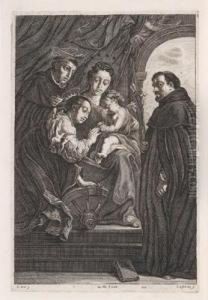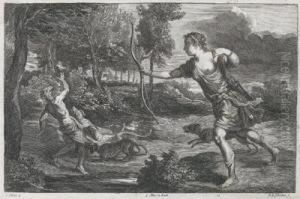Pieter Van Lisebetten Paintings
Pieter van Lisebetten was a Flemish engraver, born around the year 1630. Although not as widely known as some of his contemporaries, van Lisebetten made a significant contribution to the art of engraving during the Baroque period. His work is characterized by detailed and intricate designs, often reflecting the rich artistic culture of Flanders during the 17th century.
Van Lisebetten's career was primarily based in Antwerp, a city that was a major hub for the arts in Northern Europe, particularly known for its printmaking and publishing industry. In the vibrant artistic environment of Antwerp, van Lisebetten was able to hone his skills and become part of the thriving community of artists, including painters, engravers, and publishers.
Although there is limited documentation on his personal life, Pieter van Lisebetten's artistic output suggests that he was well integrated into the artistic circles of his time and may have worked for or collaborated with other artists, publishers, and printmakers. His engravings often included religious scenes, portraits, and allegorical images, which were popular genres during the Baroque period, reflecting the tastes of both the ecclesiastical patrons and the growing middle class.
Van Lisebetten's works were typically created through the technique of line engraving, which allowed for fine detail and a high level of control over the image. This technique was well suited to his style, which often included elaborate textures and nuanced shading, conveying a sense of depth and realism to his subjects.
Pieter van Lisebetten died in 1678. While he may not have achieved the same level of fame as some of his contemporaries, his engravings remain as a testament to the skill and artistry of the engravers of his time. His works continue to be of interest to collectors and scholars of Baroque printmaking and provide insight into the visual culture of 17th-century Flanders.

